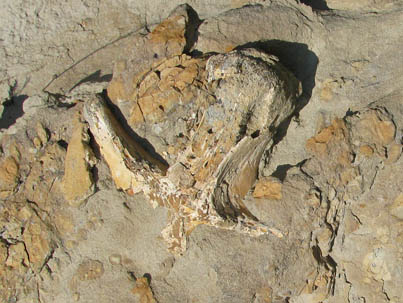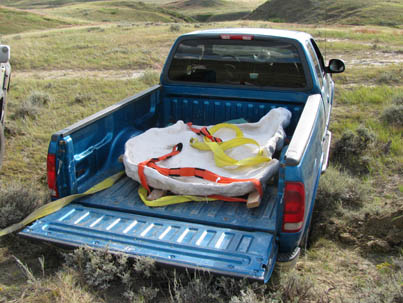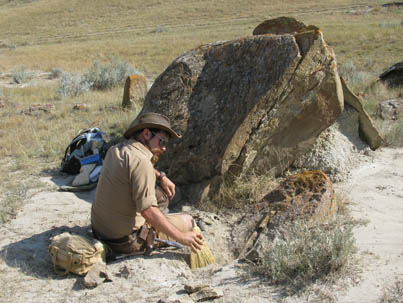Fieldwork

Discovering new dinosaurs
Fieldwork is essential to make the new fossil discoveries that drive scientific research, increasing our knowledge of Earth's history. New fossils also build the museum collection, providing the raw material for new exhibits.
Our fieldwork program is one of the largest in the region, spending up to three months in the field every year.
Currently, we are collecting dinosaurs from the Hell Creek and Judith River formations of Montana and North Dakota. These rock formations record the end of the Cretaceous Period, shortly before dinosaurs become extinct 66 million years ago in the K-Pg mass extinction.

Judith River Formation
The Judith River Formation was deposited ~79-76 million years ago. At this time, northern Montana was a vast floodplain with deltas and coal swamps reaching out into the shallow seaway that covered the Dakotas and what became the central United States. Historically, very few good dinosaur skeletons have been collected the Judith River Formation, despite it having been studied for over 100 years.
Since 2017, our field crews have been working two exposures of the Judith River Formation. In this time we have discovered some remarkable sites, including multiple disarticulated and articulated tyrannosaur skeletons; a mummified duckbill arm; two bonebeds recording the catastrophic death of dozens of duckbills; partial skulls of adult and juvenile horned dinosaurs; and many microsites.

Hell Creek Formation
The Hell Creek Formation of Montana and the Dakotas was deposited ~67-66 million years ago, and records the last non-avian dinosaurs to have lived before the K-Pg mass extinction.
It is famous for dinosaurs such as Tyrannosaurus, Edmontosaurus and Triceratops, which are common fossils in the Hell Creek. We collect our fair share of these giants, but our fieldwork especially focuses on the less common dinosaurs, including rare species or young growth stages of larger species.
We currently work mainly in Montana, where we have important research sites, but would like to expand our operation into southwest North Dakota and will be exploring for some new localities in 2021 and beyond.
Volunteer on a field crew
Our field crews are mostly made up of volunteers.
We usually ask for a commitment of at least two weeks (although this is flexible depending on circumstances, especially experience). Campsites can also be quite remote, and very basic without amenities. We typically work a six-day week with one day each week set aside for resupplying in town. Digging can be very hard physical work, in hot weather and rough terrain. Volunteers therefore need to be fit, and we insist on volunteers having valid health insurance. For legal reasons volunteers must be aged 16 or over.
If you are interested in volunteering on one of our summer field crews, then please see our Fieldwork Volunteer Page for more details of our program and how to apply, and/or email denver.fowler@dickinsongov.com.

Please consider donating
Many institutions are downgrading their fieldwork programs, favoring the purchase of commercial specimens, or even limiting or closing their collections.
Badlands Dinosaur Museum is committed to fieldwork; to make the discoveries that are needed to keep science moving forward; to fill our museum with new dinosaurs and other fossils to inspire new generations.
Our experienced field crew has identified many new dinosaur sites. However, the amount of time we can spend collecting new dinosaurs is directly related to how much money we can raise for the field program. Don't believe what you read in the news: dinosaurs do not cost millions of dollars to dig up! Our fieldwork is streamlined, and cost effective. In 2017 we spent less than $3000 on fieldwork, yet made many important discoveries.
Even if you can't offer financial support, we are ever in need of supplies and equipment.
Please see our support page for details on how you can help our paleontology program.
Fieldwork news
-
 25
Nov
25
Nov
New species of tyrannosaur dinosaur discovered by Badlands Dinosaur Museum
Read more[Nov-25-2022] Researchers from Badlands Dinosaur Museum today published a research paper which describes a new species of tyrannosaurid dinosaur. Elias Warshaw and Denver Fowler
-
 09
Sep
09
Sep
2 JOBS: MUSEUM EDUCATOR & FOSSIL PREPARATOR
Read more2 FULL TIME POSITIONS – MUSEUM EDUCATOR & FOSSIL PREPARATOR Badlands Dinosaur Museum at Dickinson Museum Center (City of Dickinson, North Dakota, USA) is proud
-
 23
Dec
23
Dec
Raptor braincase discovered by Dickinson scientists
Read moreDecember 23rd, 2020: New research from Badlands Dinosaur Museum describes part of a braincase from the dromaeosaurid “raptor” dinosaur Saurornitholestes. Read more on our Press
-
 05
Nov
05
Nov
FREE EVENT: Annual Field Report (Nov 19th)
Read moreANNUAL DINOSAUR FIELD REPORT (Nov 19th 6pm): Dr. Denver Fowler and Dr. Liz Freedman Fowler present the latest discoveries from our summer fieldwork digging dinosaurs,
-
 19
Aug
19
Aug
DINO DAYS in the Field
Read moreWatch how the paleontology field crew from Badlands Dinosaur Museum finds and digs up dinosaur bones in the beautiful badlands of Montana! This summer, the





